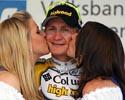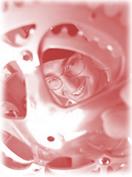
Recently on Cyclingnews.com |
|
|
View from the lab - Ric Stern's Tour de France sports science
British ABCC coach Ric Stern (www.cyclecoach.com) is a regular contributor to Cyclingnews' Form & Fitness section along with being a full time coach. Still an active rider when time allows, Ric will be providing a physiological insight into the challenges that face the riders in the Tour.
July 16: Stage 14 - Attacks keep coming
Attacks keep coming
Part two of the Tour de France started today with the next few days in the Pyrenees. After a few small hills in the early part of the stage the scene was set for the final two climbs: the hors category Port de Pailheres and the category 1 climb to the finish at Ax-3 Domaines.

|
As I briefly mentioned yesterday the majority of riders will have now accumulated a lot of fatigue. In some cases this will be a lot of fatigue - especially for riders who are lower placed in the general classification, and even some of those higher in the classification. Added to this were some heavy attacks by the T-Mobile team, which dispatched the Discovery riders to the back of the race, leaving them unable to aid Lance Armstrong.
Fatigue certainly seems to have struck at least one highly placed GC rider: Santiago Botero. Although I have to speculate on this (there could be other factors) it would initially appear that he is heavily fatigued, as he came in over 29 minutes down today and plummeted down the general classification. It's difficult to speculate why this has happened, but Santiago could be ill, plain exhausted, suffering with glycogen depletion, or maybe he'd just had enough.

|
One the other hand, at the other end of the peloton, we see two riders who had mixed fortunes today - Alexandre Vinokourov and Christophe Moreau. After Vinokourov's great ride into Briancon I naturally assumed he would be right at the front today, but after attempting a few attacks he lost ground quickly and finished several minutes back (although he did move up the GC). Moreau however, lost ground and lost his third place on GC as he slipped back to 10th overall. In both of these riders' cases, there must be some fatigue in their bodies, but it may just be that they don't have the necessary power to mass ratio to race with those right at the front. I discussed power to mass in this entry.

|
To increase power to mass ratio there are various training methods (a couple of which were discussed in the July 12th entry), and of course the other option is to lose weight (fat mass). Although both these riders (Vino and Moreau) look very lean, it's often possible for the amateur cyclist to lose some weight, through increased training (volume and/or intensity) or small reductions in food, or small changes in diet to 'better' foods. However, it's imperative to keep consuming large quantities of carbohydrates to fuel your exercise. For riders who train around 12 hrs/week, they may need around 7g of carbohydrate per kg of body mass per day (e.g, 490 grams for a 70kg cyclist). Prior to starting a weight reduction programme, you should establish how much weight (fat mass) it's safe to lose. At RST we use metal (not plastic, which are useless) skinfold callipers to assess the sum of the skinfolds, which enables us to estimate body fat percentage. Additionally we've also used hydrostatic weighing (you are weighed under water) which when used with certain assumptions allows sports scientists to estimate body fat percentage. Once body fat percentage has been established clear guidelines can be drawn up to arrive at a new body weight.

|
Back to the race - on the Pailheres climb we saw that T-Mobile launched two initial attacks, which distanced the Discovery team and at one point put Lance under pressure. These two initial attacks were then followed up with attacks by Ivan Basso (who has been quiet in the Tour thus far) and and then Ullrich. This quick succession of attacks was perhaps the only way that Basso and Ullrich could think of to distance themselves from Armstrong. With both of these riders taking it in turns to rid themselves of Armstrong, he would have had to counter all of the moves, burning through his glycogen stores at a faster rate than usual. This could have led him to fatigue earlier on the stage (which it didn't do) or could leave him more fatigued for the horrendous stage tomorrow.
We saw that after Vino was distanced on the Pailheres, he did an excellent descent to catch the maillot jaune group (although it did appear that they eased up a little). What was interesting, was that pretty much as soon as Vino had caught the group and the climb started and he was off the front again. It takes guts to keep attacking, and Alexandre seems to have that in plenty.

|
On the final climb a superb victory by Georg Totschnig was somewhat overshadowed, by the action further behind. With Armstrong and Basso (almost) coming in together and Ullrich just behind, it appears that these three are the fittest riders and perhaps this will be the final GC. Whatever happens, tomorrow will be a horrendous day in the Pyrenees, with six major climbs and the finish climb at Pla d'Adet. Maybe Basso and Ullrich will attack again, and perhaps Rasmussen will have a better day. Only if the other riders constantly attack can they hope to take the race away from Lance and prevent the race unfolding the way he wants it to
2005 entries - the Tour de France
- July 28 - Stage 21 - What it takes
- July 23 - Stage 20 - Getting the TT right - and wrong
- July 22 - Stage 19 - The perfect break
- July 21 - Stage 18 - High intensity and fatigue
- July 19 - Stage 16 - Maintaining an attack
- July 17 - Stage 15 - Tour's biggest day
- July 16 - Stage 14 - Attacks keep coming
- July 15 - Stage 13 - Positive thoughts
- July 14 - Stage 12 - Hot, hot, hot!
- July 13 - Stage 11 - Big efforts uphill
- July 12 - Stage 10 - Number crunching
- July 7 - Stage 6: The dynamics of a breakaway
- July 6 - Stage 5: Coming back after a TT
- July 5 - The TTT - Man, machine and team
Previous Cyclingnews features by Ric Stern
- Winter Training
- Weight training and cycling - The Great Debate
- Power zone training - How to set training levels with a power meter
- Ric Stern also answers Cyclingnews readers' questions in our Form & Fitness Q&A section

